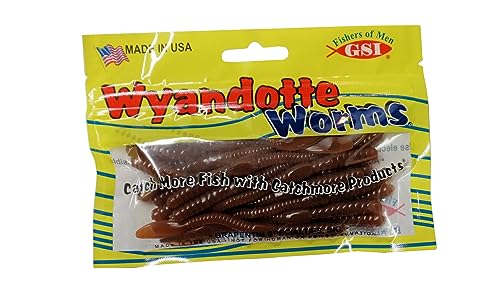Product Review: Kalkal Deck Boots
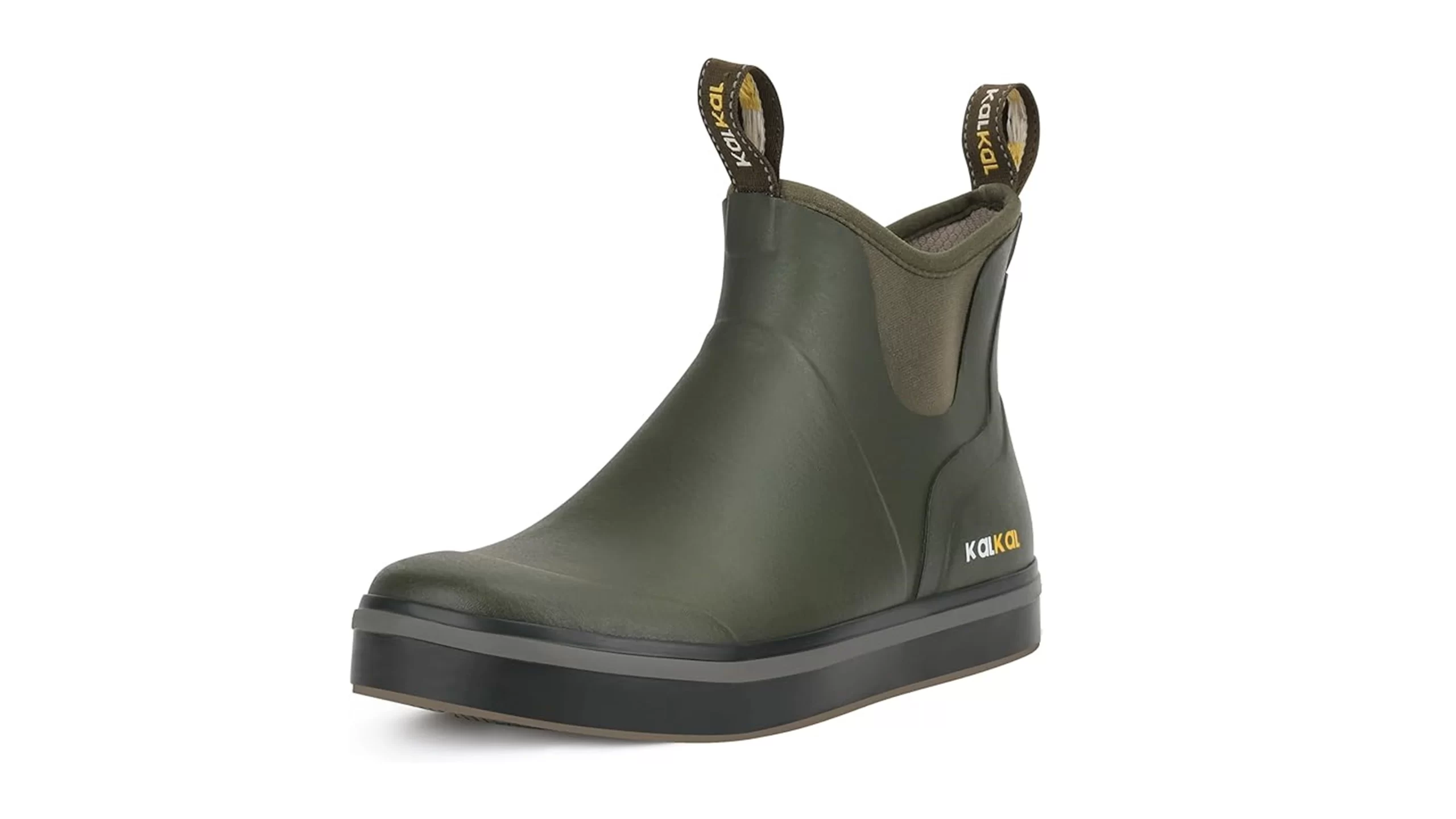
* This page contains affiliate links. The Great Lakes Fisherman may earn a commission on items purchased through these links. For more on this, please click here.
We’ve all had those moments when fishing from a wet, slippery surface where you feel like your next step will put you on the deck or in the water. If you own a boat with a fiberglass, vinyl, or other type of non-carpeted decking, you’ve probably had more of these moments than you can count. So what can you do get a better grip in these wet conditions, while keeping your feet perfectly dry and comfortable? Maybe it’s time for a pair of deck boots. In this article, I’ll review Kalkal’s deck boot so you can decide if it’s the right boot for you.
Grip/Traction
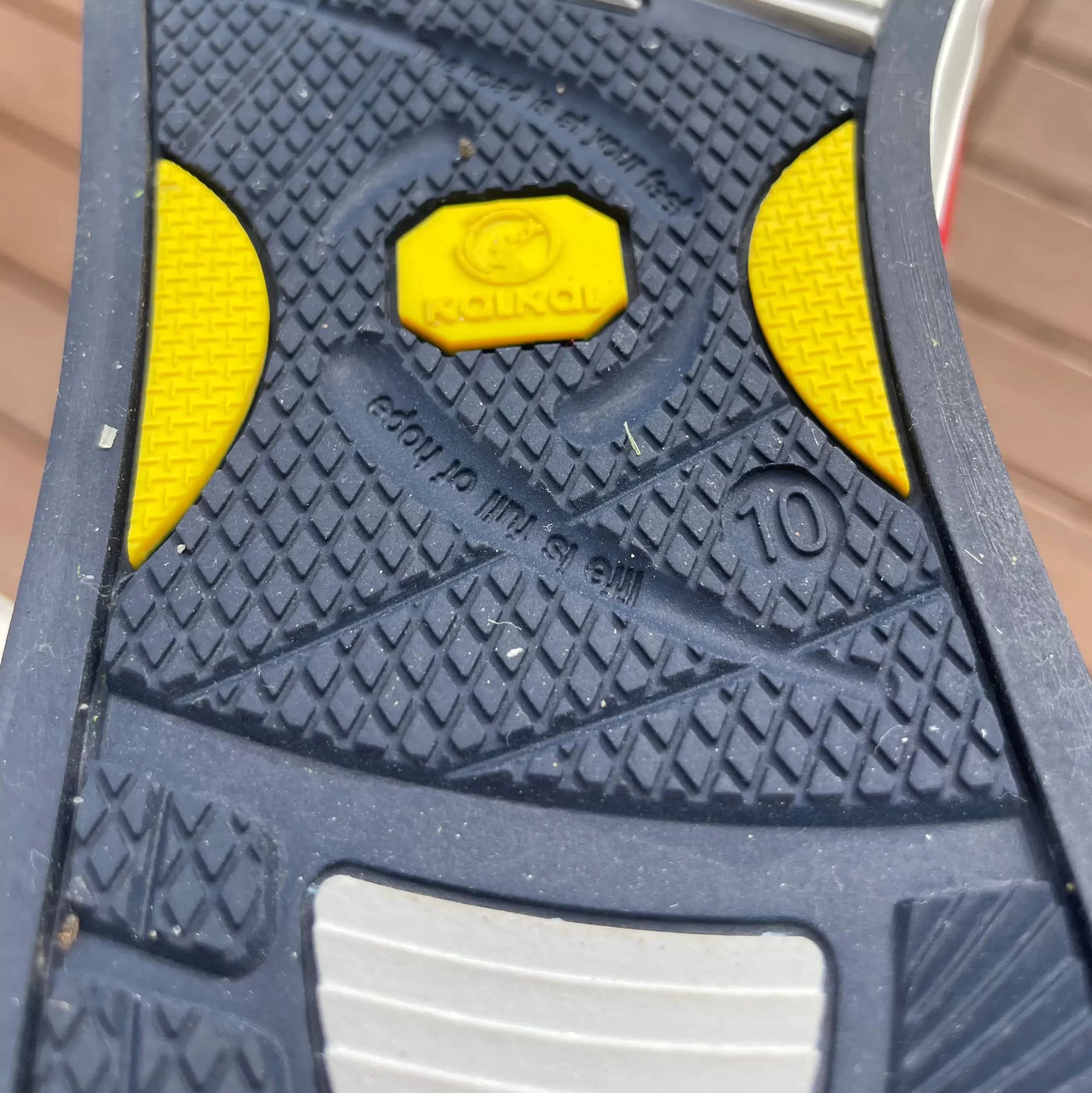
The grip of these boots is very solid. I had no problems working in the rain on my vinyl decking. I had high confidence in my footing and never felt like I might slip. The deep grooved design of the sole provides space for the water, allowing the boot’s sole to maintain constant contact with the surface.
Comfort
I give these boots get very high marks when it comes to comfort. They are some of the most comfortable boots that I’ve ever worn. First, the neoprene lining is very soft against the skin, making them perfect for slipping on and off when needed, even when barefoot. In addition, they are waterproof and will keep your feet dry and warm in the wettest of conditions. Finally, the cushioning inside allow you to enjoy long hours on the water without aching feet. My wife even tried them on and remarked on how comfortable these boots were!
Style
Kal-Kal offers several color styles to match your preference: Black, Army Green, Gray, Blue and Brown. So no matter what activity you engage in from boating to sailing to fishing or even hunting, there is a color pattern for you.
Practicality
The best way to make use of these boots, in my opinion, is to keep a pair on your boat or in your car or truck. This keeps them accessible anytime rain or wet conditions present themselves, whether planned or not. And the pull tabs make them easy to pull on and off when needed.
Some of the best uses for these boots are as follows:
- Boats with hard decking (vinyl, fiberglass, wood)
- Marinas
- Pier or dock or jetty fishing
- Launching and retrieving boats (wet boat ramps)
Cost
These boots are right in the middle of the price range when it comes to modern deck boots of comparable design. They can be purchased on Amazon for between $50 and $60 depending on size and preference.
Conclusion
These deck boots from Kal-Kal offer a perfect solution for those activities that require you to stay focused while on slippery wet surfaces. Whether you are a boater, sailer or fisherman, a pair of these deck boots kept with your car, truck or boat will help ensure you stay dry, comfortable and slip-free in those wet, slippery conditions.
Best Bait for Finding Crappie
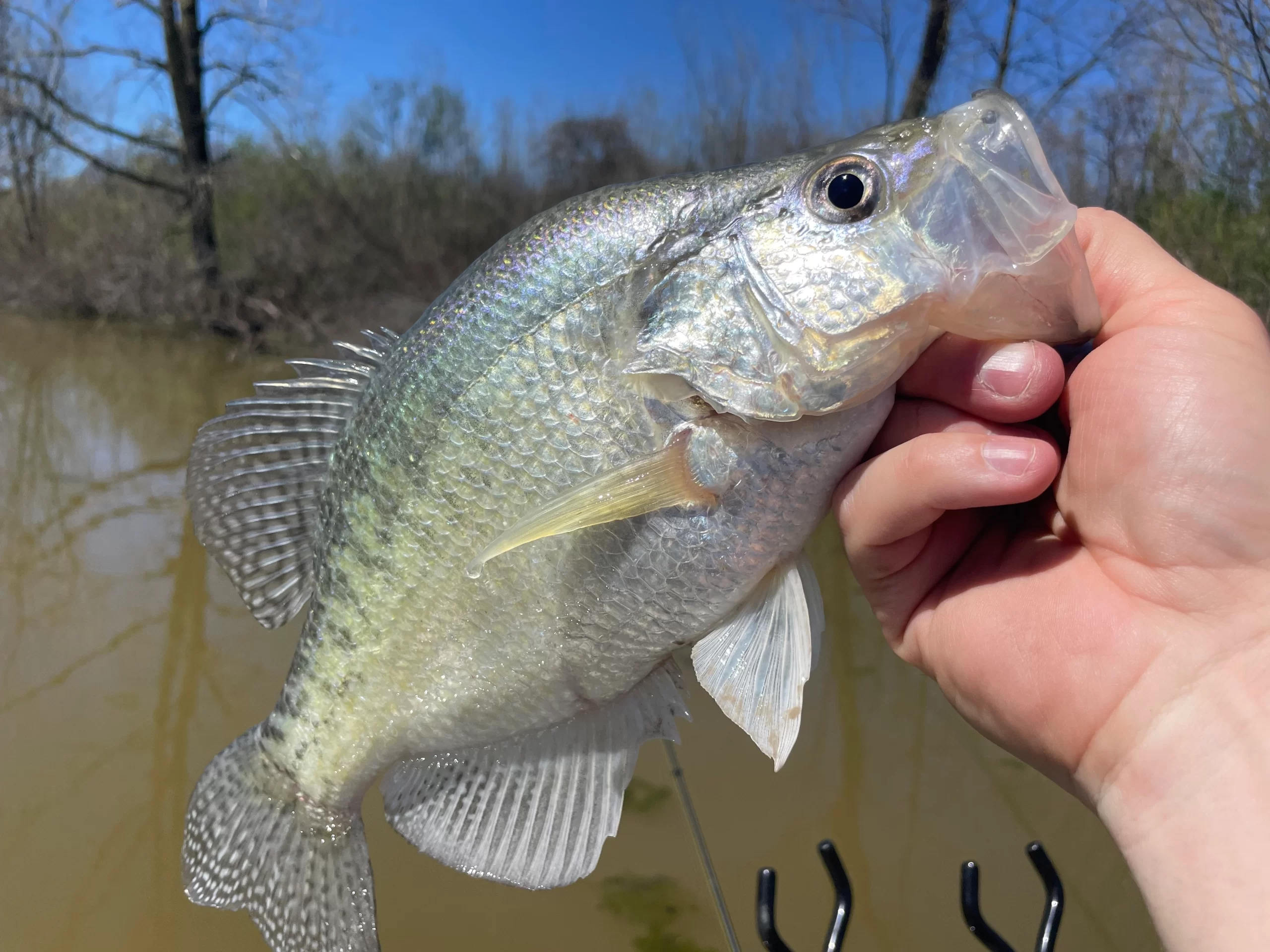
* This page contains affiliate links. The Great Lakes Fisherman may earn a commission on items purchased through these links. For more on this, please click here.
When fishing a new lake for crappie, the first and biggest question is where to begin? This can be answered by taking a look at a lake map and eliminating water that likely holds no fish. The second question is, what is the best bait for finding crappie. And to that question, I have the answer: a 1/16 ounce jig with a Charlie Brewer Slider.
Why It Works
All lakes have minnows. While other forage may be present in any given body of water, with a few exceptions, minnows are a staple for crappie in nearly all inland lakes in North America. A jig rigged with a Charlie Brewer Slider, when fished properly, does the best job of imitating minnows, in my 40+ years of fishing experience.
How to Fish This Bait
There are two very effective ways to use this bait. First, it can be slow-trolled. This can be done by long line trolling the jig behind the boat. But for crappie, the more common method I like to use is spider rigging.
Another way to use this bait, when fishing around structure is to cast it and retrieve it. Here is how I do it.
First, cast the jig out to the location you are checking for fish. Then let the jig drop to the depth you believe them to be. Now retrieve the bait back to you by simply giving the rod a slow lift while reeling in very slowly in an effort to hold the bait at the same depth the entire way through the retrieve. This is KEY! In doing so, you can methodically check multiple depths by letting the bait fall a little more with each cast by counting it down.
Favorite Color Patterns
In the clear waters of the Great Lakes Region, I prefer to use the baby bass pattern with a chartreuse tail. This is hands-down the most productive pattern for me. Other colors that produce are orange/chartreuse, chartreuse, and white. Good luck out there!
Top Plastic Jig Baits for Detroit River Walleye
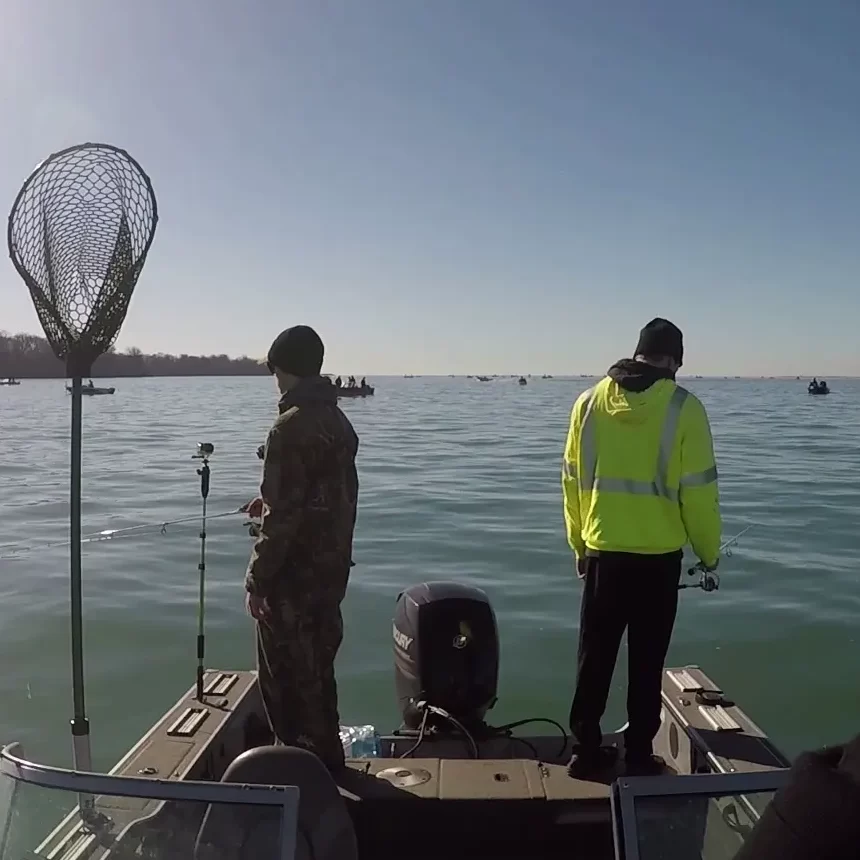
* This page contains affiliate links. The Great Lakes Fisherman may earn a commission on items purchased through these links. For more on this, please click here.
Walleye fishing on the Detroit River should be on every walleye fisherman’s bucket list. Nowhere in the world are walleye more concentrated then they are in this river during the spring spawning run. But even if you miss the spring spawning run, there are very good numbers of walleye present in the Detroit River all year. For those who have or intend to fish it, here are some of the top plastic jig baits for Detroit River Walleye in no particular order.
Blue Ice
Blue Ice is a great color pattern for walleye when the river is very clear. This pattern has a more natural look in the water and is possibly the top minnow imitator when the water is at its clearest. Use a matching blue ice jig head for maximum effect. For a little added color flair, dip the tail in a chartreuse dye called Spike-It.
Purple Ice
Purple Ice is another effective bait on the Detroit River. Like Blue Ice it is effective in clearer water due to its natural pattern. Again, Spike-It can add a bit of color to catch the fish’s eye.
Wonderbread
Wonderbread is a great pattern for when the water is more stained. The overall white body color stands out and the little flecks of color help to catch the fish’s eye in the cloudier conditions.
Pimp Daddy
Although I haven’t used this one to date, I hear a lot of fisherman have had success with this pattern. Pimp Daddy has a natural body with a bright tail. It’s another great bait to use in semi-clear conditions.
#1 Wyandotte Worm
Although at times not the most effective, the Wyandotte Worm will usually catch fish any time of year. It’s a standard that any Detroit River walleye fisherman should have in their tackle box!
Basic Equipment for Spider Rigging
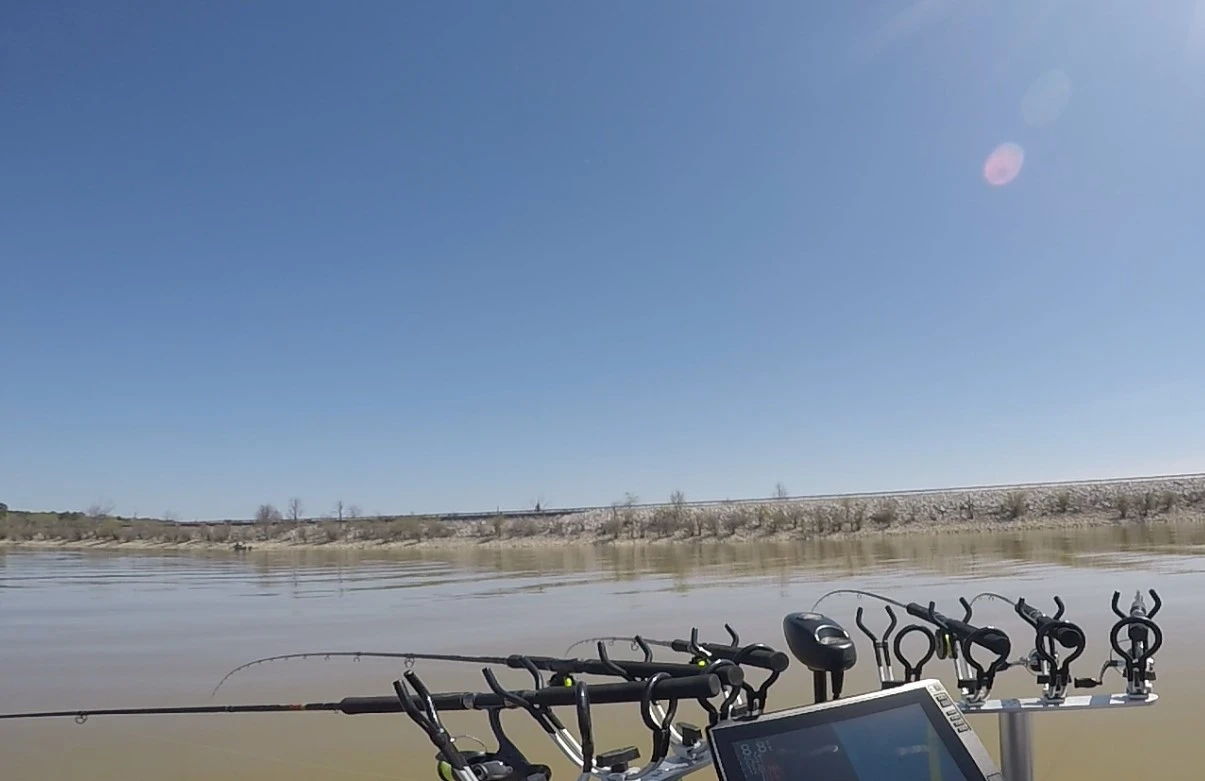
* This page contains affiliate links. The Great Lakes Fisherman may earn a commission on items purchased through these links. For more on this, please click here.
Crappie fishing one of my favorite species of fish to chase. This is because they are found in most fresh water lakes and streams, they’re a prolific breeder, meaning that they are found in large numbers, they are one of the best tasting fish, and they are a perfect target for young anglers. And probably the most productive way to catch these fish is using a technique known as “spider rigging”. But what is the basic equipment for spider rigging and how can you get started?
Spider rigging is a slow trolling technique whereby the trolling rods are placed horizontally off the boat with the baits trolled directly under the rod tip. This is done by using a heavy weight to keep the line from swinging back too far. In addition, long specialized rods are used to get the baits far enough from the boat such that the crappie aren’t spooked. These rods can be up to 16′ long or even longer!
In this article, I’ll go over the setup and the basic equipment necessary to get started in spider rigging.
The Boat
By definition, spider rigging is done from a boat. Many different boats can be used for this. While boats with some sort of front deck, such as a bass boat, are the most popular, many other boats can be used. In fact, the very first time I was introduced to spider rigging was on a pontoon boat. I have also seen small 12′ jon boats set up for spider rigging.
The Rods
The rods used for spider rigging start at 12′ and get as long as 20′. The length of the rod you’ll need is dependent of a few factors including the size of your boat, the depth of water you intend to target, and the clarity of the water. For most anglers, 14′ is the standard rod length, but more and more anglers are opting for 16′ rods, especially when trolling in very shallow or clear waters where the boat may spook the fish more easily. A great rod to get started is the Buck’s Graphite Jig pole by B’N’M in 14′ length.
The Reels
The reels for this don’t need to be anything special. Because of the rod length, the fish will often just be lifted and swung into the boat with no reeling necessary. I would go cheap here. These reels are a great choice.
Rod Holders
This is the third and final requirement for getting into spider rigging. You’ll need a rod holder for each rod. These rod holders are mounted in a horizontal oriention so that when placed in the holder, they are level with the water. These holders should be mounted on the boat where you plan to sit. The most popular location for this is at the front of the boat because as the boat moves in a forward direction, the baits trolled here are the least likely to spook the fish.
While rod holders can be mounted individually, the most popular way to do this is to mount a tree with 3-4 rod holders mounter to it. This allows 3-4 rods to be accessed from the same sitting position Usually, 2 of these trees will be mounted at the front of the boat, with one left of and one right of the bow. In this way 6-8 rods can be accessed from one or two seats mounted on the front deck. There are several styles of these, but a popular one is this one made by Millenium Marine.
Dual Seat Mounts
Many crappie fisherman like to setup the front of their boats for 2 anglers to fish side by side. This setup is great for taking a kid or a buddy fishing and is one of my favorite ways to fish, period.
In order to mount a second seat to the deck of your boat, you’ll need a specially made mounting system like this one from Millenium Marine. You’ll want to check to be sure that your boat’s seats fit this mount. If you’d prefer to buy the seats with the mount, a pair of these are popular and will go with the mount above.
The Line
High vis line is highly recommended for this application. When running 3 or more rods, it can be difficult to see bite on any given rod. The high vis line helps tremendously here as you can see any movement more easily, especially i f the fish pulls sideways, which often happens in shallower water.
I use 6lb. test for the main line and use 4 lb. flourocarbon for the rig material.
The Rig
The rig starts with an egg weight slid onto the main line. This weight will ideally be as light as necessary to keep your lines from trailing back. You want the lines vertical. I typically use a 1 oz. egg weight but you can go heavier or lighter based on the baits used and the speed trolled.
Next, I tie on a standard barrel swivel followed by an 18-24″ leader made of the 4 lb flourocarbon line I mentioned earlier. Finally, a 1/16 oz. jig with your favorite plastic is tied on to the end of the leader. My all around very favorite bait to use in this application is the original Charlier Brewer Slider in various colors on a 1/16 oz. chartreuse jig head.
How to Catch Walleye at Night
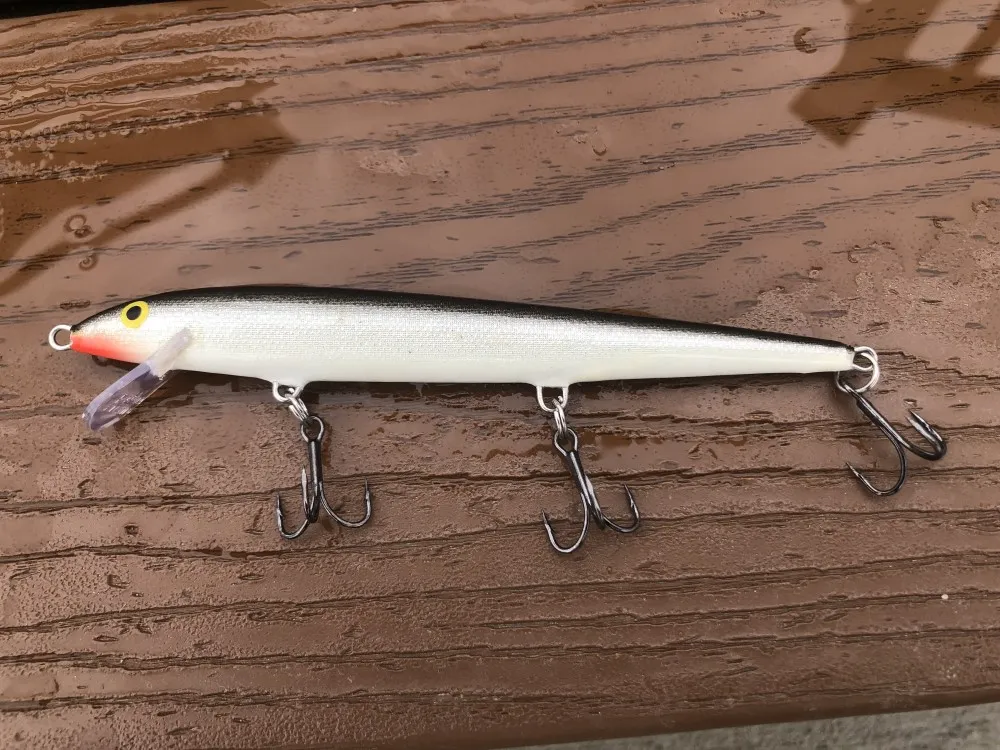
* This page contains affiliate links. The Great Lakes Fisherman may earn a commission on items purchased through these links. For more on this, please click here.
Walleye are a great fish to eat and can be caught any time of the day when using the right technique. This makes them a very popular gamefish. But one of the best times to chase these toothy critters is at night. That’s when walleye become the apex of apex predators. And when fishing for them at night there is one lure that shines above all others: the original floating Rapala!
Walleye are very light sensitive and prefer low-light coniditions. This same light sensitivity means that they have excellent night vision. This gives them an enormous advantage over many other fish species when night falls. So when the sun hits the horizon, walleye will often move into shallower water to chase prey.
For the angler, this means coming up with the right color combination for the fish to see well. In low light conditions, the rod cells of a fish’s eyes are doing the predominant work. They don’t detect color, only shades of grey, black and white. But they can see these contrasts very well, even in their peripheral vision. This means that contrasting black and whites are easily seen in these conditions. And this is what makes the original floating Rapala so effective.
The Rapala can be effective by casting it if you are fishing from shore. Find areas along the lake or river that tend to hold bait fish on waters where walleye are known to live. If you are in a boat, the most effective technique is to troll it along the same bait filled shallow waters. Trolling parallel to the edge of weed beds is particularly effective.
We have used this technique on many different bodies of water. From the smaller walleye lakes of Ontario to the Detroit River and the Great Lakes and it has proven to be effective on all of them.
And fishing at night has some advantages. The lake is much quieter at night as most boaters have docked for the day. This leaves much of the lake available to fish. In addition, in the heat of the summer, when many of us have time to fish, the night bite can be more comfortable from a temperature perspective (just don’t forget the bug spray).
So if you haven’t tried night fishing for walleye in the summer, be sure to give it a try. And don’t forget the original floating Rapala. It’s likely the only bait you’ll need.
Spike-It!
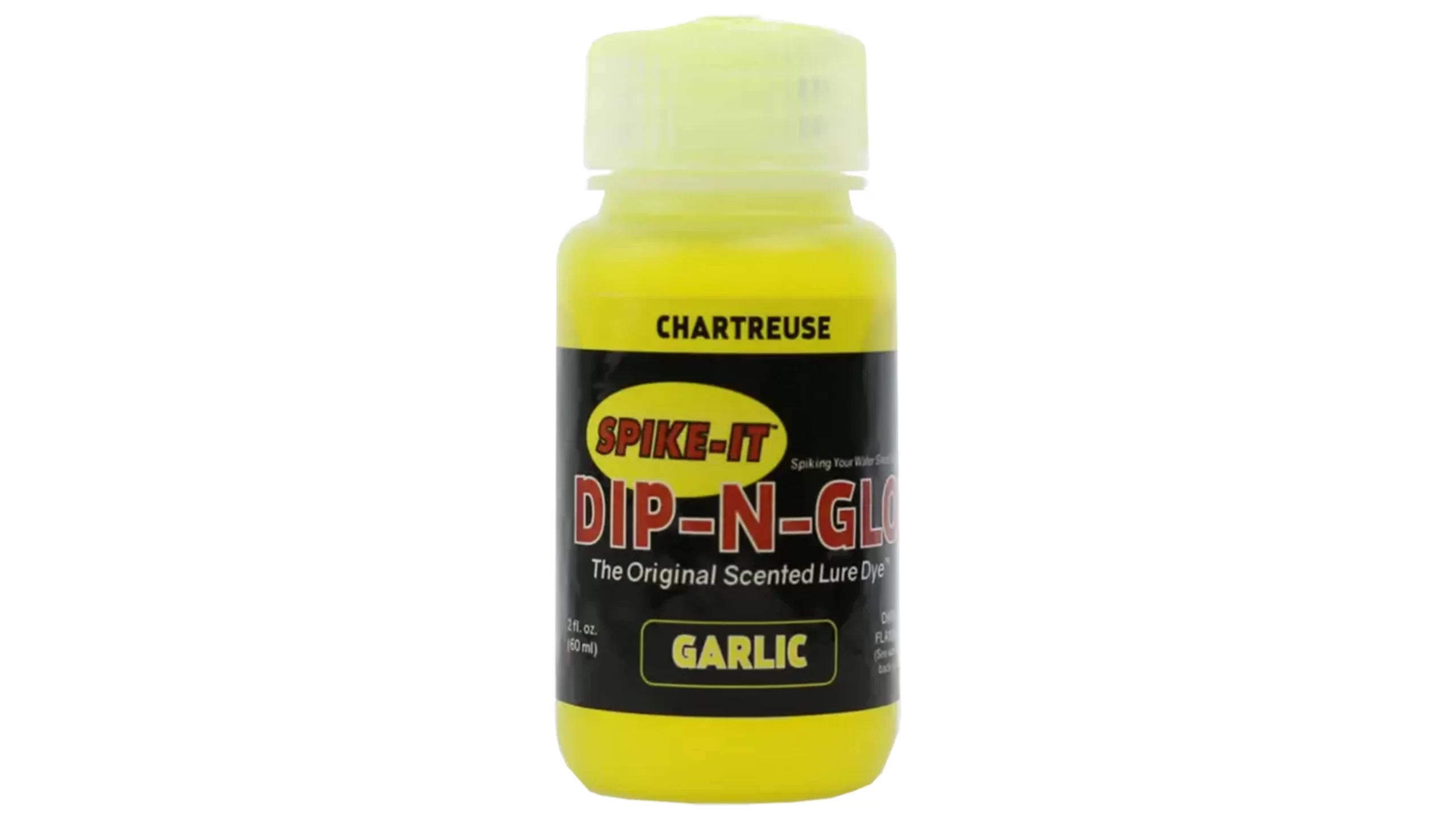
* This page contains affiliate links. The Great Lakes Fisherman may earn a commission on items purchased through these links. For more on this, please click here.
Visibility and scent are two of the three main ways fish sense their prey (vibration is the third). They are also the ones fish rely on the most. When fishing, it is therefore important that we try to make our baits appeal to these senses as much as possible. And there is a product on the market that I have come to rely on that really helps in that endeavor. The product is known as Spike-It.
Spike-It is essentially a dye that comes in various colors and flavors. I like to use the product to add visibility to my plastic baits. Rather than buy different plastics that have all sorts of different colors, which can get rather expensive, I just buy Spike-It and when my bait needs a flash of chartreuse or pink, I just dip the tail of the bait in bottle and I’m good to go.
Chartreuse is probably the color I use most often, but hot pink is another popular choice. Remember, it is often just a flash of color that catch’s a fish’s attention. And it sometimes only takes that little something extra to go from being skunked to putting a limit in the boat.
I have used this product successfull for crappie, walleye and bass. And it often increases my catch rate immediately. I usually like to add the color to the tip of the tail of the plastic bait, which is usually the part of the bait that has the most action in the water.
Another great feature of Spike-It is the ability to add color without changing baits. This is great when you’re locked onto a school of fish and don’t want to take the time to tie on a new bait. With Spike-It, just a quick dip and you’re ready to go.
If you use a lot of plastic baits when fishing, Spike-It is a product you must try. You likely won’t spend better money than you will on this product!
The One Flasher/Fly Combo You Must Have
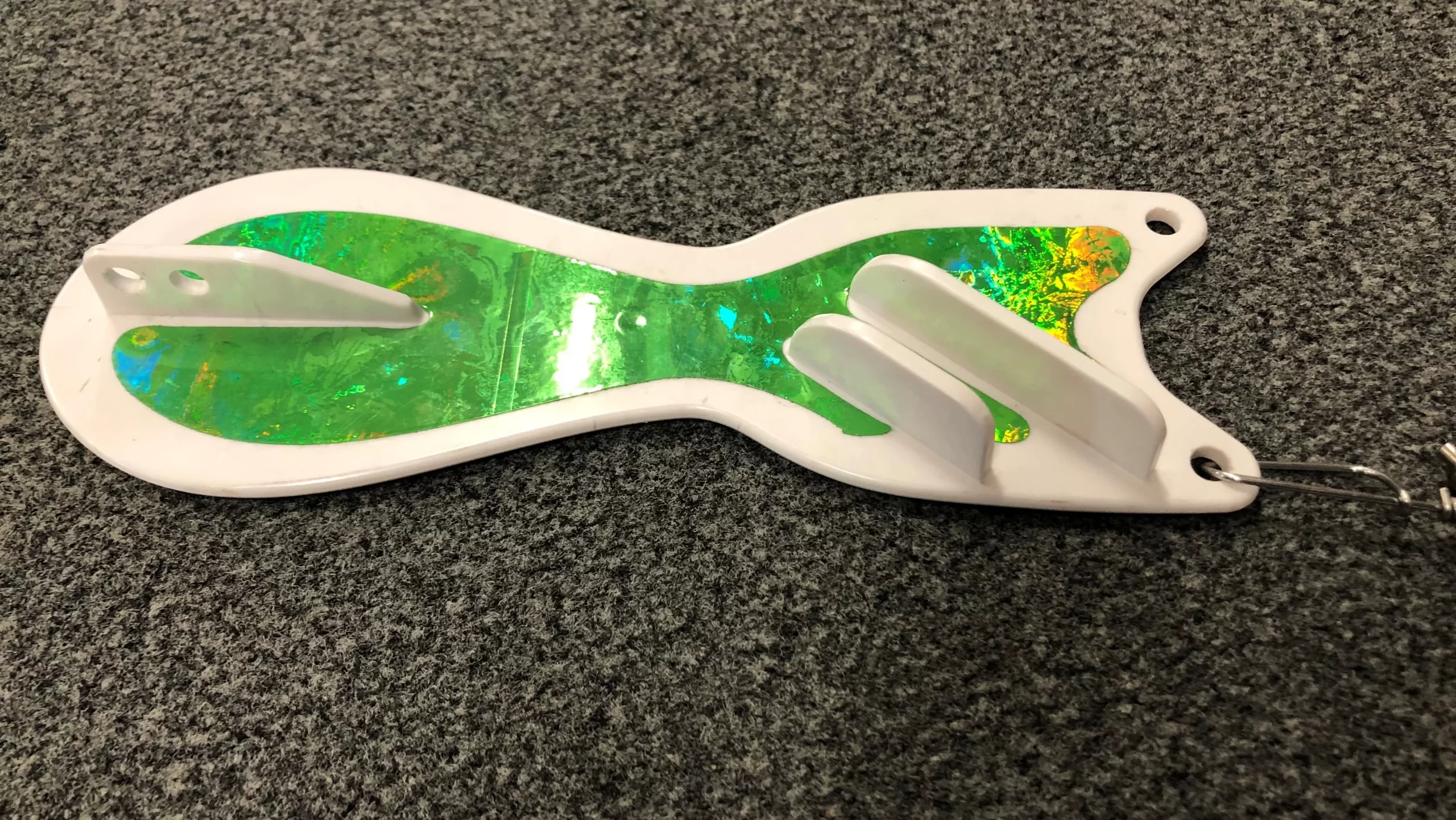
* This page contains affiliate links. The Great Lakes Fisherman may earn a commission on items purchased through these links. For more on this, please click here.
Flashers and flies have been used for years as part of a salmon fishermen’s trolling spread. When the right color is used, the bright flash allows fish to see rig from many feet away, even in deeper water. And when they do, the darting movement of the fly chasing it is irresistable. But what is the best flasher/fly combo color combination to use?
While there are many colors that can and do work, some work better than others in certain conditions. But if there was one color combo that you want to be sure is in your setup at all times what would it be? Well that’s easy. The one flasher combo I make sure I always have in my setup is a green spin doctor with a green/tinsle fly. Here’s why.
Green is the color that stands out most prominently in relatively clear and deep lake water. The reasons for this are a bit complex and for a full explanation, you can watch this video. But suffice it to say that green wavelengths from sunlight penetrate great lakes waters deeper than other colors. And because fish spend much of their lives swimming in this deeper water, the color green looks much more like what they’re chasing down there, than other colors. (Red for instance doesn’t show up at all in deep water).
Now don’t get me wrong, this is not to say that other color combinations won’t catch fish. They certainly will and I have caught many salmon on other colors. But green will usually outfish any other color combo out there, over time. It is especially effective when the fish are in the deeper water in mid summer.
If you don’t believe me, just pay attention to the color selections most tackle shops long Lakes Michigan and Huron carry. About 2/3 of them include green or hues of green as part of the color scheme. If you still don’t believe me, go to Dreamweaver’s website and sort their Spin Doctors by popularity.
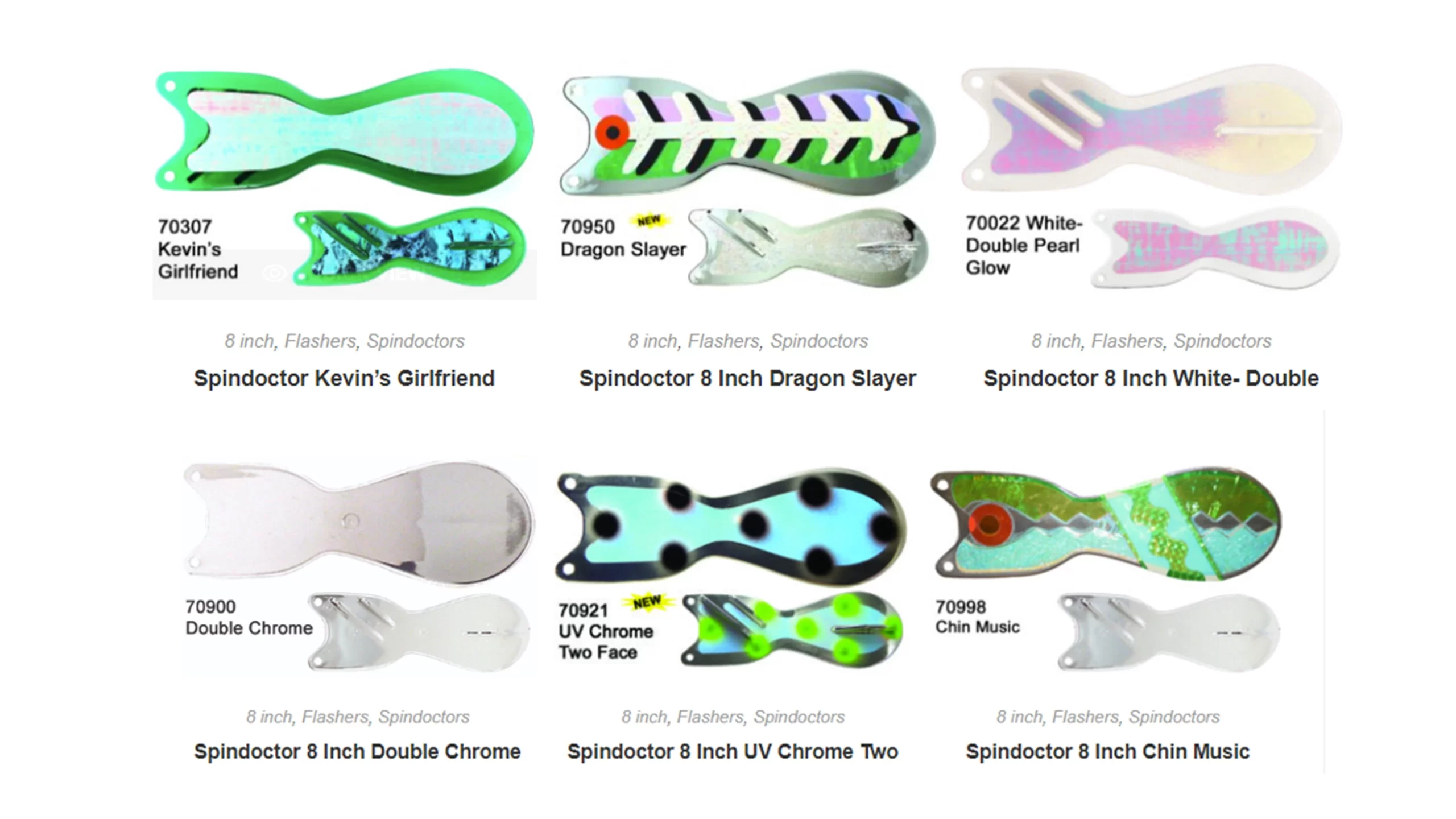
As far as size goes, a lot of that depends on your preference and target species. I have found the 8″ model to be a great size for all species, but pick whatever size you find works best for your setup.
Now as far as which exact pattern works best, that’s less important than the color, in my opinion. We have had a lot of success with various patterns. The important thing is that it include green as a the main color. Some great options are:
Kevin’s Girlfriend
Dragon Slayer
UV Green/Yellow
The fly running behind the Dipsy should also be green but with some tinsel or flashabou mixed in. The flash will help keep the fish focused on the fly. This has, by far, been the best flasher/fly combo I have ever used.
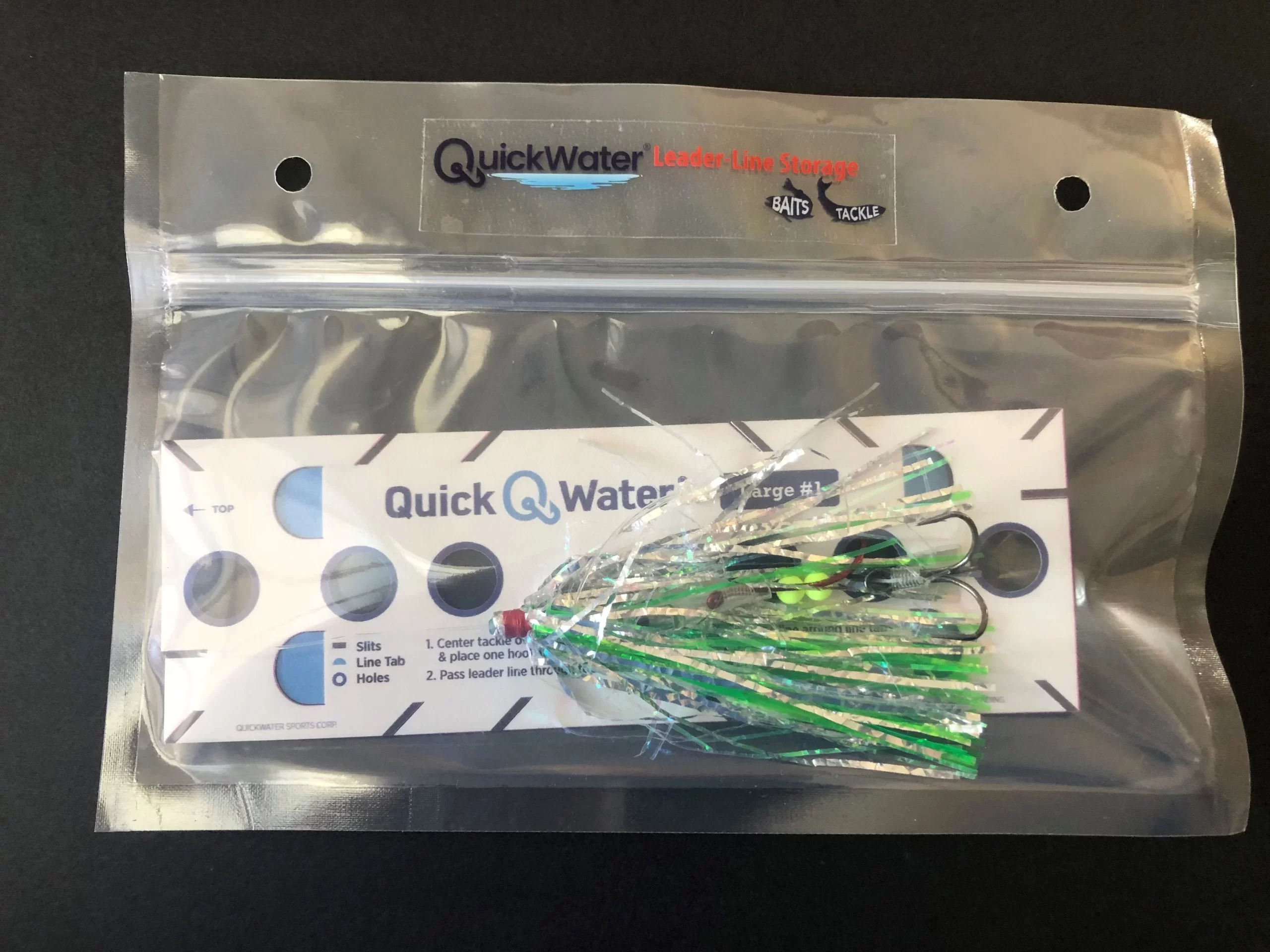
In addition, I have found that the best color for Dipsy divers is, you guessed it, green. When running these flasher/fly combos on Dipsy rods, we always run them off of a green dipsy. I have 4 of these on my boat and can run both High and Low Divers using this color. If you don’t feel the added green helps, use a black Dipsy.
So give green a try. Keeping at least one of these setups in your trolling regimen is almost certain to improve your catch rate.
Livescope…Yes, It’s Worth It!
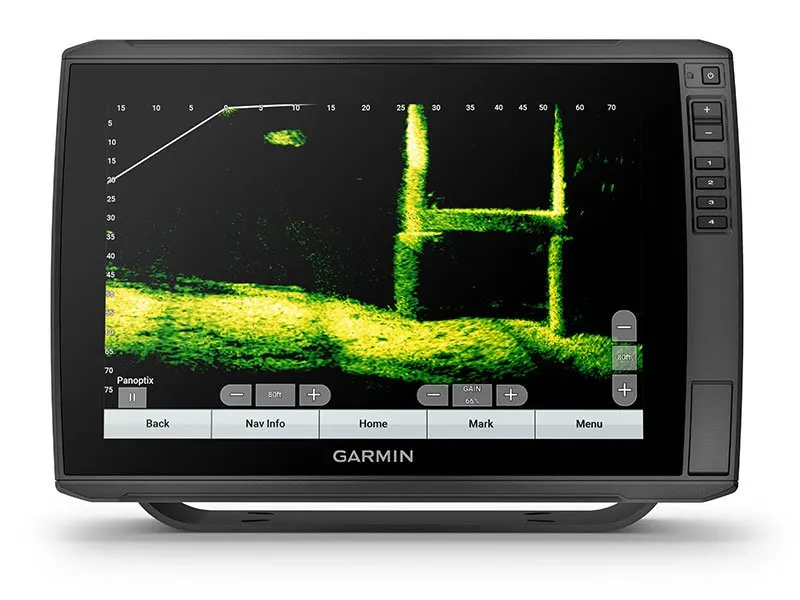
* This page contains affiliate links. The Great Lakes Fisherman may earn a commission on items purchased through these links. For more on this, please click here.
There’s been some debate on the use of livescope technology. Does it really help you find fish quicker? Does it help you catch fish faster? Is it worth the money? And to all of these questions, I would answer with a resounding yes!
This, of course, doesn’t mean that everyone should go out and buy a livescope unit. In fact, I would not recommend that you do so unless fishing is a pretty serious part of your life. But there are reasons why it makes sense, even financially, if fishing is something you love to do, not just even if, but especially if you don’t get to go very often.
Before we go on, I want to point out that while I am using the term livescope generically, the term is actually the name of the Garmin version of live sonar. But because that is the widely used term for the technology in the industry, I am using it here in the generic sense. When referring to the Garmin version, I will use the term, “Livescope” with a capital L.
Should You Buy Livescope?
The first thing you should think about is how much you like to catch fish as compared to how often you get to fish. If you love to fish, enjoy the pursuit of finding them organically, and have lots of time to do so, livescope may not be for you, especially considering its high cost.
But if you don’t have a lot of time to fish each season, but really value putting fish in the boat, especially if you enjoy keeping them for table fare, then livescope is highly recommended. Now you may think it’s cost prohibitive, but it’s not as bad as you may think.
First, think about all of the fishing equipment you have purchased over time. A fishing boat is probably the most expensive piece of equipment you’ve ever purchased for fishing. It gives you the flexibility to go where the fish are, right?
But as the old saying goes, 90% of the fish are in 10% of the lake. So if you leave it to random chance, you’ll spend 90% of your time not finding many fish. If you only get to go fishing a handful of times each summer, that’s not very good odds, unless you tend to fish the same body of water over and over again.
Now of course, there is traditional sonar which most boats and fisherman have. So this gives you a reading when fish are under the boat. This is great in deeper water where the fish aren’t easily spooked. But what about the ones that are off to the side?
Well, for that, there is sidescan technology. This can help with seeing fish off to the side, but sidescan has its own limitations. The sidescan will tell you that there are fish there, but it won’t tell you if those fish came from the area under your boat and were spooked to the side of your boat. And we all know from experience that spooked fish are not that likely to bite.
But with livescope, you have the ability to watch the fish reacting to these scenarios. I have been out spider rigging for crappie and watched schools of them scatter just shortly before my baits actually reach them. This is invaluable information to a fisherman in real time. With this knowledge, I can change my approach to casting, which allows me to reach the fish without spooking them.
Finally, electronics on boats tend to have a long lifespan. When you buy your first unit, the bells and whistles of any future enhancements won’t compare with the advantage you gain from just being able to see the fish’s behavior on the screen in real time. So if you never want to upgrade, you won’t be missing much.
So Which Unit to Buy?
Like all things, this is really a matter of cost and preference. Watching them on demo mode at a store like Bass Pro Shops or Cabela’s will give you a good idea of how the unit looks and feels. Lowrance, Humminbird and Garmin all have their own versions.
Personally, I chose Garmin Livescope and can tell you that I have zero regrets. The unit has been very reliable and consistent in it’s performance. I paired it with a Garmin 12″ head unit. The large screen makes it very easy to see, even on bright sunny days, without straining.
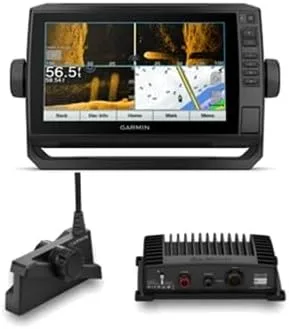
At the time I bought mine, the total cost for the head unit and the Livescope transducer was about $4500. If I were buying today, I would probably purchase this bundle from Amazon. This provides you with a 9″ display head unit and their latest Livescope Plus transducer.
If fishing is something you really enjoy, but are frustrated with coming up empty handed on the few trips that you make each year, or if you’re just frustrated in general with not being able to catch fish that you know are there, consider a livescope unit. You will never regret the purchase!
Early Spring Fishing on Lake Michigan

* This page contains affiliate links. The Great Lakes Fisherman may earn a commission on items purchased through these links. For more on this, please click here.
If you’re getting cabin fever and looking for something to get you out of the house, why not try some early spring fishing on Lake Michigan? With the winter ice all but gone, the shores of the lake are heating up both literaly and figuratively. And although some days can still be quite nasty out, there are often some really nice days sprinkled in. So here are a couple of ways you can get out and take advantage of some of what Lake Michigan has to offer this time of year.
Before we get into it, just a quick word of warning. Lake Michigan is very cold this time of year and there are not nearly as many boats out to help you if you get into trouble. So be sure that you don’t go alone and that you have good communication in the event of an emergency. And as always, make sure all of your boat’s safety gear is up to par. With that said, let’s get into it!
Pier Fishing
Once the ice is clear, you’re almost certain to find anglers on almost any given pier or jetty on the nicer days. These anglers are often chasing steelhead, espeicially on piers that are at the mouths of major tributary rivers.
Using fresh spawn is usually the bait of choice either suspended under a bobber or drifting near the bottom. The bottom rig typically consists of a pyramid weight sliding on the mainline, a barrel swivel, a 3-6′ leader and finally, a hook with the spawn bag. The spawn bag here should have a few foam beads mixed in to provide buoyancy and keep the spawn off the bottom.
Another common method of pier fishing is casting spoons. Little Cleo’s or other heavy spoons of various colors and glow-in-the-dark varieties are thrown around these pierheads to attract steelhead and young salmon looking for an easy meal.
Trolling the Beaches
If you have a boat, another popular way to enjoy a nice late winter day is to troll for salmon & trout along the beaches. And when I say beaches, I mean it. This time of year, the fish come very close to shore to take advantage of alewives and other bait fish that are concentrating in these warming waters.
It is not uncommon to to find fish in less than 20 FOW during late winter/early spring time period and once you find a pattern, you will often find a fast limit. And if you like salmon, these are sure to be some of the best tasting you will ever eat.
Perch Fishing
And last, but certainly not least, is the phenomenal perch fishery that the southern part of the lake has to offer.
But be aware that unlike some of the other perch hotspots in the Great Lakes, such as the western basin of Lake Erie or Lake St. Clair, perch in Lake Michigan can sometimes be found quite deep. And when I say deep, 70′ is not uncommon.
When fish are found at this depth, especially when the water is cold, the bite can be very difficult to detect. It is advised to use braided line in these instances as it’s low-stretch characteristics will telegraph the bite to the rod much better.
Whatever you choose to do on Lake Michigan during late winter and early spring, it’s sure to be the cure for your cabin fever.
Slow Down Your Retrieve for More Fish
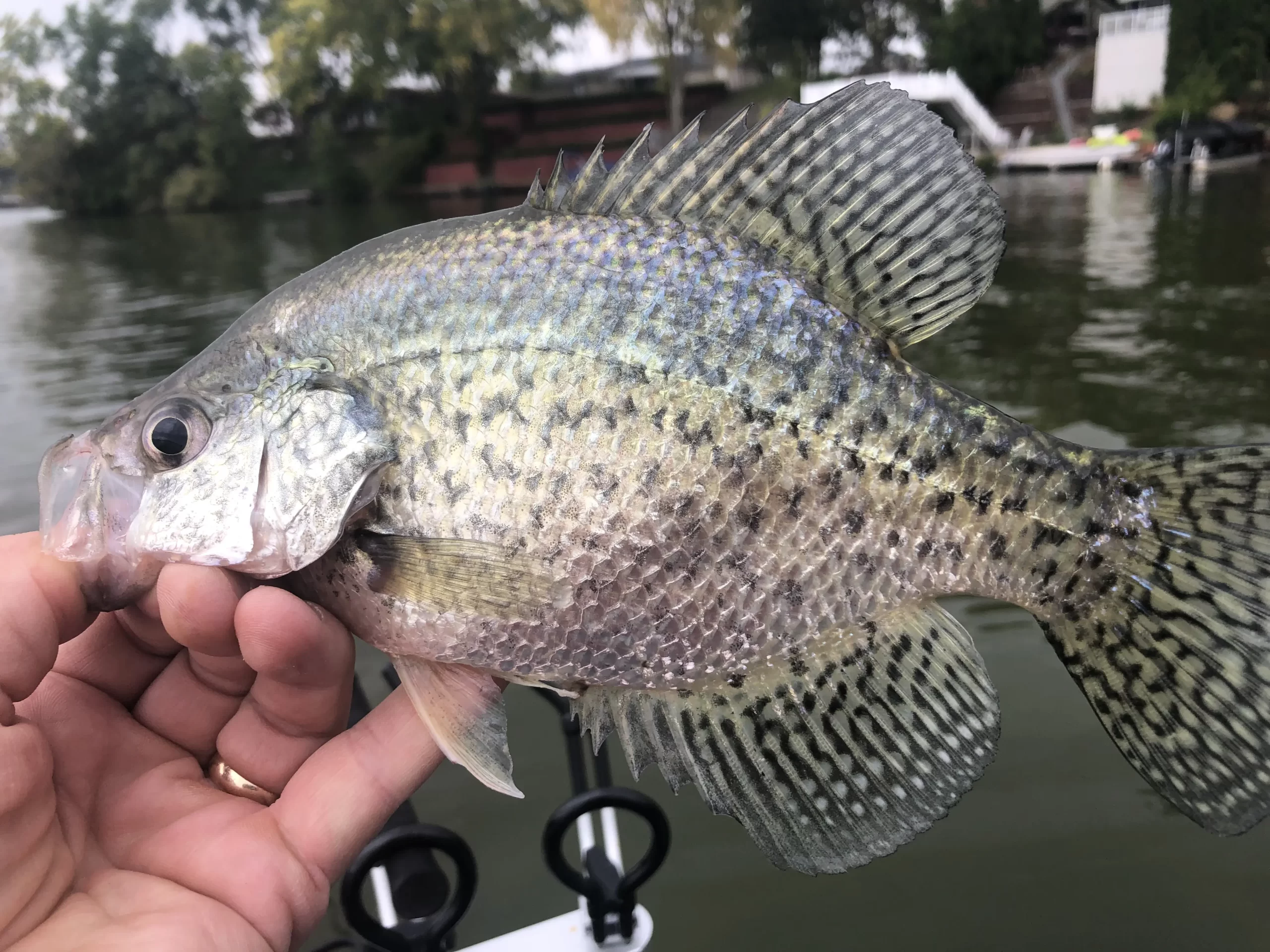
* This page contains affiliate links. The Great Lakes Fisherman may earn a commission on items purchased through these links. For more on this, please click here.
One of the most common mistakes I used to make as a novice fisherman, was fishing too fast. Don’t get me wrong, there are times where a fast retrieve makes perfect sense. But if you want to catch more fish, learning to slow down your retrieve in the right situations will pay huge dividends.
There are many reasons to slow down your retrieve, but probably the most important one, especially in the Great Lakes region, is that fish are often located in cool or even cold water. Water at 15 to 20 feet deep can be much cooler than the water at the surface. And because fish are cold blooded, this means that their metabolism will be lower as well.
Metabolism
So how does this translate into the need to slow down your retrieve? Metabolism is the process by which an organism breaks down food. When metabolism is slow, the organism tends to be more judicious in how aggressive it is. This means that fish will likely not use a lot of energy when chasing prey. Which means that faster moving baits are less likely to be chased.
When I was young, I would watch fishing shows on TV and try to mimick what I was seeing. What I didn’t understand at the time was how different the conditions could be in the lakes that many of these shows were filmed on. Many of these shows were filmed in the south and the waters down there are much warmer than they are in the north. Once I started to realize that the fish don’t have the same metobolic rate in the north due to the colder conditions, I began to slow down my presentations and immediately began to catch more fish.
Now don’t get me wrong, some species have higher metabolism than others. Northern Pike, for example, tend to have relatively high metabolism in cold water as compared to many other freshwater fish. Because of this, they do well in colder water. This is one of the reasons that they thrive in the north but as a species, tend to struggle in the warmer waters of the American south.
But many species, such as crappie and bass, will often react to a slower presentation, especially in the spring and fall. One technique I like to use, especially for crappie, is to cast a jig out, let it drop to the right depth and then retrieve it by simply lifting the rod tip and letting the jig “fall” back to the boat. The key is to lift the rod tip at a rate that, combined with the fall, results in the bait swimming back relatively level. In order to accomplish this at the right speed, you may need to adjust the weight of the jig. I like to start with a 1/16 or even 1/32 oz jighead.
Changing the way you fish can take a little practice. But once you learn to slow down your retrieve, you will find a new tool that, in the right conditions, will help you catch more fish.


))/3107326.json)


))/3775968.json)
))/2703975.json)
